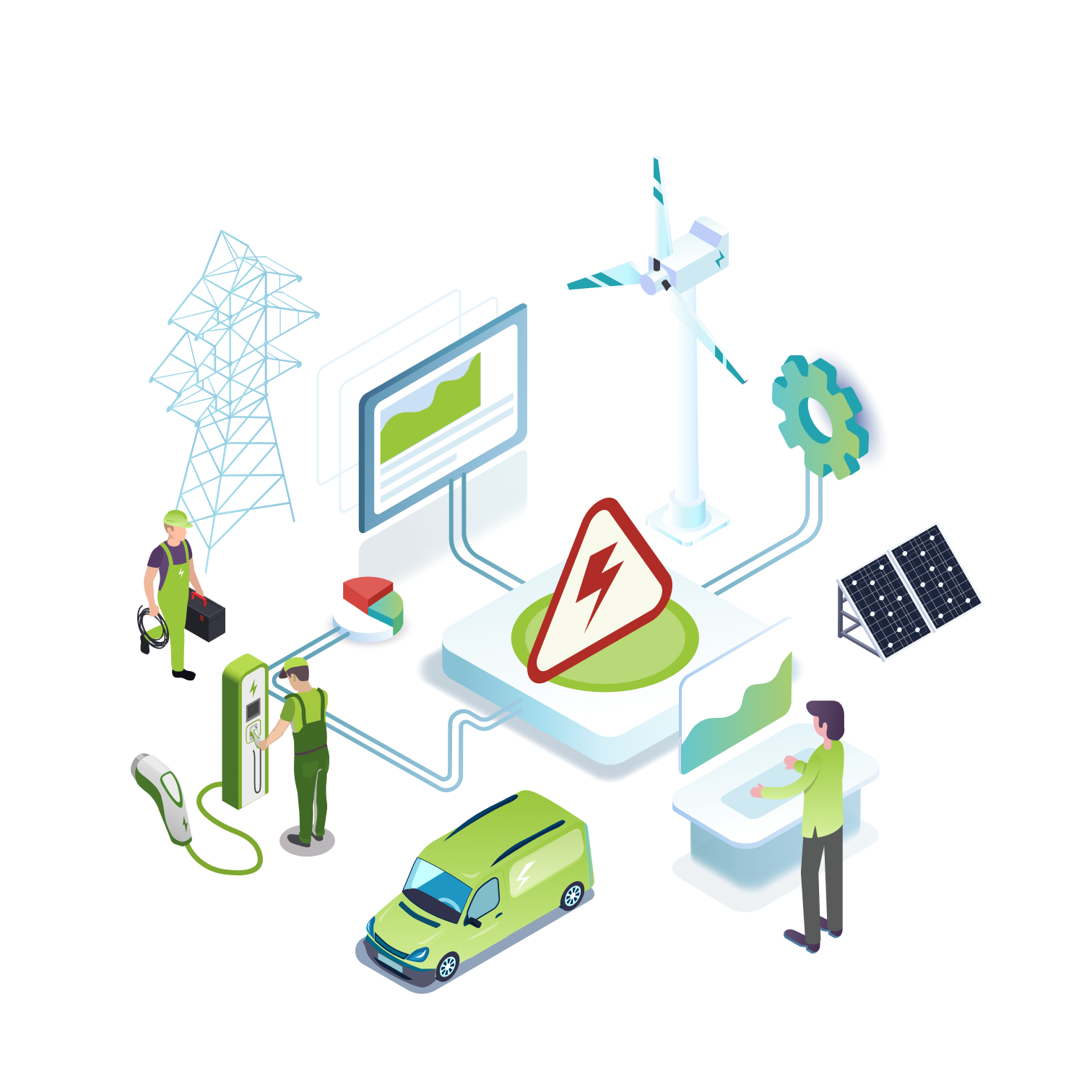E-Mobility opportunities and challenges in the Energy & Utility sector

- MOBILITY
- E-MOBILITY
- SMART CITIES
A large share of electric vehicles on Europe's roads in the future will have implications for the electricity generation and distribution infrastructure, which means energy and utility companies are forced to provide more resources. What's more, Europe's vehicle-emission regulations are forcing car manufacturers to increase the volume of EV sales each year. Energy and Utility companies are focusing on covering utilization with renewable resources to meet the daily needs of consumers.
Today's vision of the decarbonized world is strongly connected with e-mobility, supported by governmental goals to decrease the number of fuel-engine cars in the following decades. It contributes to creating a new demand segment for energy and utility companies playing a tremendous role in the e-mobility system. Yet, one of the biggest challenges for the EV market is the lack of charging infrastructure. The European Union targets 1 million charging points by 2024 and 3 million by 2029. About 240 000 new charging points are needed yearly to accomplish the target of the EU; companies in the Energy sector have a significant impact on it.
Charging Infrastructure
Now that the electric vehicle charging system is about to become a general phenomenon, electric car owners can choose from different types of charging methods: private charging points equipped at home, semi-private charging points such as offices, hotels, retailers, transport hubs, and last but not least, public charging points in cities to provide better well-being for car owners. The wide variety of charging options shows how significant the potential in e-mobility for energy companies and how unique the position of the energy and utility market in private and public charging is.
New grid systems
Our grid infrastructure is ageing, and it is pushed to do more than it was traditionally designed to supply. As peak demand for electric cars rises, increased grid system capacity is needed. Therefore, distribution and transmission systems operators are developing new electricity management systems to satisfactorily control charging points connected to the grid system. Modernizing the grid infrastructure is crucial to make it more resilient for cutting-edge technologies and controls that communicate and work together to deliver electricity more efficiently. The transformation is both an opportunity and a challenge for energy and utility companies to fulfil the increased needs of consumers.
Long-term investments
Providing charging points for electric car owners is both an investment for nature and the services providers in the long term. As the European Union pushes governments for sustainability, utilities must consider opening new charging points to serve possible new consumers, as experts prognostic 80% share for electric vehicles by 2050. Electric cars can significantly reduce direct emissions of CO and air pollutants from road transport; therefore, implementing new chargers also help the long term goal of global awareness.
New partnerships with sustainability service providers
Mobility, especially e-mobility creates a unique environment for partnerships, as the market is a constantly emerging area in transportation and city well-being. Utilities should continue to work with fleet owners, retailer companies and smart city planners to contribute to the mission of the European Union.
Electric vehicle charging platform
Grape Solutions’ electric charging application, Montu is a customized development for e-mobility CPOs and their users. Montu fulfils the needs deriving from drivers’ and service operators’ side by providing a complex solution for electric charging management. The development makes electric charging hassle-free by providing robust software for businesses, fleets and drivers. Montu was first implemented in Hungary to provide a business solution that facilitates the process of charging electric vehicles from the National Energy Utility Provider by providing a user interface and facilitating communication between the eMSP and the Charge Point Operator (MVM Mobiliti).

Share this post on social media:
Posts by Tag
- IoT (17)
- Smart cities (16)
- E-mobility (14)
- Energy Management (10)
- Mobility (9)
- Software development (9)
- Marketing automation (6)
- RPA (6)
- Robotic Process Automation (6)
- electric vehicles (6)
- Internet of Things (5)
- IoT solution (5)
- Marketing software (5)
- Smart Building (5)
- Business Intelligence (4)
- Custom applications (4)
- IoT platform (4)
- Uipath (4)
- electric charging (4)
- IoT devices (3)
- Properties (3)
- AI (2)
- BI (2)
- Montu (2)
- Multi-device functionality (2)
- Omnichannel (2)
- RPA Budapest (2)
- Smart city (2)
- UX design (2)
- app development (2)
- artificial intelligence (2)
- crm (2)
- crm software (2)
- electric charging station (2)
- machine learning (2)
- marketing campaign (2)
- optima (2)
- API Testing (1)
- Agriculture (1)
- Automated Testing (1)
- BYOD (1)
- EV (1)
- Energy Communities (1)
- Event insights (1)
- Event report (1)
- Green IoT (1)
- HR (1)
- IT Outsourcing (1)
- ML (1)
- Power BI (1)
- Resource Management (1)
- Smart Home (1)
- Smart Office (1)
- TaaS (1)
- UX/UI Design (1)
- Xamarin (1)
- cloud (1)
- cloud computing (1)
- cross-selling (1)
- data driven marketing (1)
- digital twin (1)
- dynamic customer segmentation (1)
- esg (1)
- inbound marketing (1)
- industry 4.0 (1)
- onprem (1)
- onpremise (1)
- scalability (1)
- software robot (1)
- testing as a service (1)
- upselling (1)
Recent Posts
Read On

- IOT
- INTERNET OF THINGS
- IOT SOLUTION
- SMART CITIES
IoT features for solar energy systems
The electric usage of households is expanding rapidly as most home appliances are electricity-demanding. To meet these surging needs, there's an increased need to switch to sustainable resources, such as solar energy. In order to manage these complex systems, IoT systems are crucial.

- E-MOBILITY
- ELECTRIC VEHICLES
- ELECTRIC CHARGING
- SMART CITIES
Europe is set to become the global electric vehicle market leader by 2030
Analysts foresee that European Union countries will overtake China and USA in case of the highest rate of selling electric vehicles in the next few years. The European Parliament and European Council set an agreement in June 2022 that all new cars registered in Europe will have zero-emission by...

- MOBILITY
- E-MOBILITY
- MONTU
- EV
- ELECTRIC VEHICLES
- ELECTRIC CHARGING STATION
- ELECTRIC CHARGING
Can charging stations in EU keep up with the increasing number of electric vehicles?
According to EEA (European Environment Agency), in 2019, 10% of vehicles sold in the European Union was electrically chargeable, which is nearly a double increase comparing to 2018. Despite the fact, that more and more people think environmentally consciously, the trend of electric charging...



